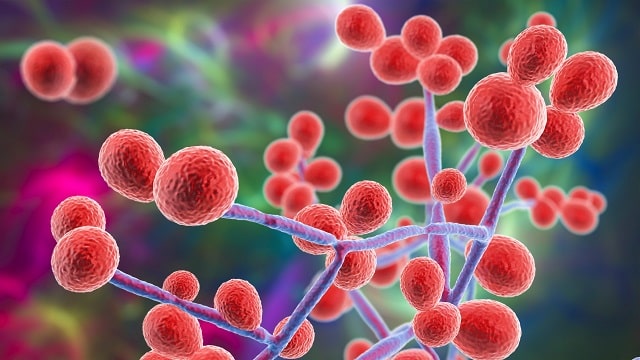Candida Albicans
Candida albicans or C. albicans is part of the natural human microflora. This means that you can find this microorganism naturally in or on our bodies.
C. albicans is most commonly found in the digestive tract. Along with countless other microorganisms, it is part of the gut microbiome.
However, this fungus also likes warm and moist environments. That is why they also usually settle in the vagina and mouth.
In small amounts, Candida albicans is generally not a problem. However, it can overgrow and turn into an infection if the healthy balance of bacteria and yeast is disturbed.
Candidiasis is a term you can use to describe an infection caused by an overgrowth of yeast (Candida). Common infections include vaginal yeast infections, diaper rash, and thrush.
Symptoms of Candida albicans Infection
Under normal conditions, Candida albicans will not cause any symptoms unless there is an overgrowth due to an imbalance of bacteria. Symptoms of this fungal infection also vary, depending on the location of the growth.
Here are common types of C. albicans infections and their symptoms:
Symptoms of vaginal infection:
- Itching and burning sensation in the vaginal area, including the labia and vulva.
- A white vaginal discharge that is sometimes described as having a consistency similar to cottage cheese.
- Pain during urination or sex.
- Redness and swelling of the vulva.
Symptoms of canker sores:
- There are white spots in the mouth that are painful.
- redness inside the mouth or at the corners of the mouth.
- Difficulty eating or swallowing.
- Loss of taste.
Symptoms of skin infection
The most common symptom of a Candida skin infection is a red rash that forms on the affected area. In some cases, blister-like lesions may also form. The skin may also thicken or produce a white substance that looks like curd.
Causes of Candida albicans Infection
Candida albicans infection or candidiasis can occur when the healthy balance of bacteria and yeast in the body is disturbed.
Here are some common causes that can disrupt our body’s natural microbial balance:
- Taking antibiotics. In addition to killing harmful bacteria, these drugs can kill the helpful bacteria that keep C. albicans growth in check.
- Hormone therapy. The growth of C. albicans in the vagina is related to the hormone estrogen. That’s why vaginal yeast infections are rare during and after menopause. Hormone therapy, however, can reintroduce estrogen and increase the chance of C. albicans overgrowth, as can high-dose estrogen contraceptives.
- Immunosuppression. Candida albicans infections are often seen in people who take medications or have health conditions that suppress their immune systems.
- Pregnancy. Increased levels of estrogen and progesterone during pregnancy are thought to encourage yeast overgrowth.
- Uncontrolled diabetes. Increased glucose levels can provide food for the yeast to grow.
Risk Factors for Candida albicans Infection
The following are several factors that can increase a person’s risk of experiencing a Candida albicans infection :
- Feeling stressed.
- Having diabetes that is not well managed.
- Having a weakened immune system or conditions such as HIV/AIDS.
- Consuming lots of refined carbohydrates, yeast, and sugar.
- Taking antibiotics, steroids, hormones or oral contraceptives.
- Pregnant women
Diagnosis
To diagnose candidiasis, the doctor will first observe the patient’s medical history and ask about symptoms.
The healthcare professional may also ask if you have any conditions or medications that can weaken your immune system, or if you have recently taken antibiotics.
Many cases of candida albicans yeast infections can be diagnosed through a physical examination.
If your doctor is unsure whether your symptoms are caused by a Candida infection, he or she may take a sample from the affected area. This sample can then be used to grow the organism and identify what species it is (culture test).
Identifying the Candida species causing the infection can help your doctor prescribe an antifungal medication that is effective in treating that species.
Candidiasis Treatment
Because the cause is a fungus, the treatment is with antifungal drugs to stop the excessive growth of these microorganisms.
The drug can come in two forms, namely:
- Oral or taken by mouth, such as pills, liquids, or lozenges.
- Topical. Creams or ointments applied directly to the affected area.
Complications
Candida albicans can be dangerous if it spreads through the bloodstream and attacks vital organs, such as the kidneys, liver, or brain.
Prevention of Candida albicans Infection
Here are some ways that can be done to prevent excessive growth of Candida albicans by:
- Maintain good oral and physical hygiene.
- Consume healthy and balanced nutritious food.
- Manage stress well.
- For people with diabetes, keep your blood sugar levels normal.
If you are taking antibiotics or medications that can cause Candida overgrowth, talk to your doctor about ways to prevent possible yeast infections as a side effect or underlying health condition.

